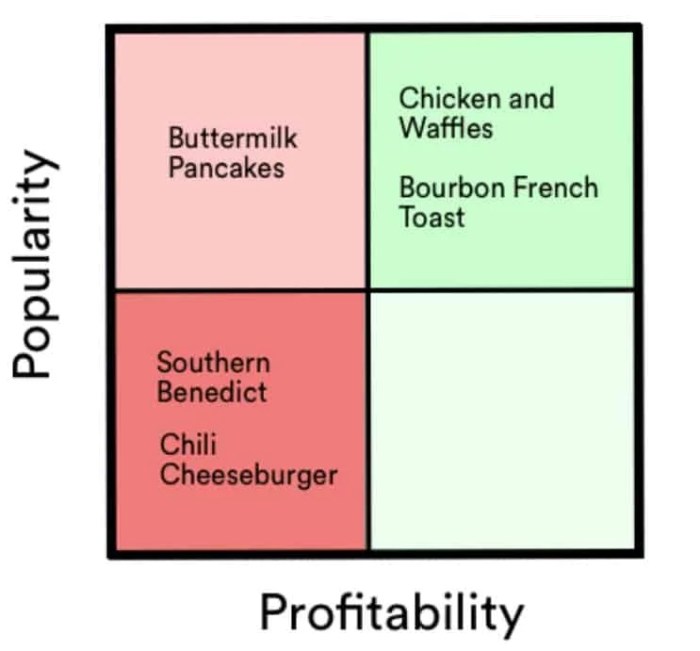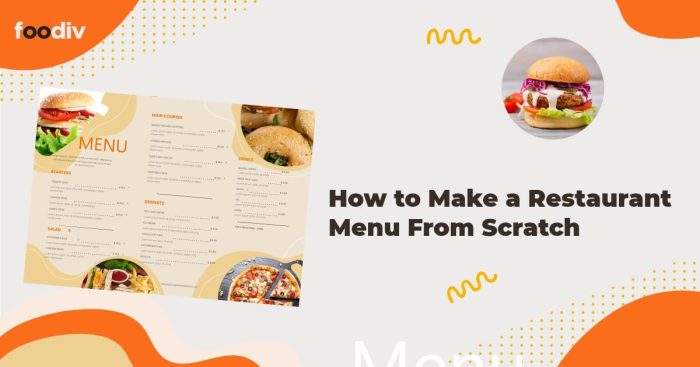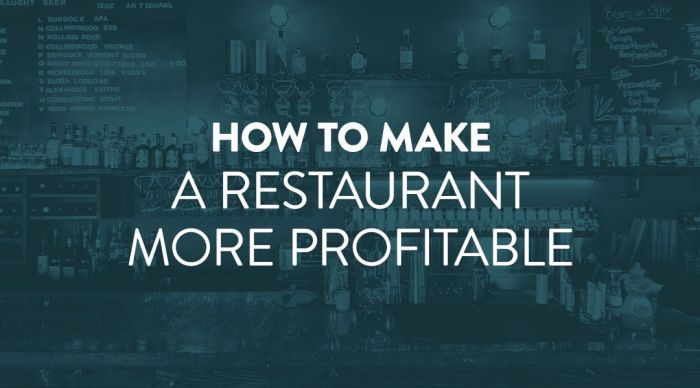Crafting a restaurant menu that maximizes sales is more than just listing dishes; it’s a strategic blend of psychology, design, and culinary expertise. From understanding your target audience and employing effective pricing strategies to creating a visually appealing layout and using descriptive language to entice customers, the process involves meticulous planning and execution. This guide explores the key elements necessary to design a menu that not only presents your food attractively but also drives sales and enhances the overall dining experience.
We’ll delve into menu engineering techniques to optimize profitability, explore different pricing strategies to appeal to various customer segments, and discuss the crucial role of visual design and descriptive language in influencing customer choices. We will also cover practical steps for menu customization to cater to diverse dietary needs and preferences, ultimately helping you create a menu that resonates with your target market and contributes to your restaurant’s success.
Menu Engineering & Pricing Strategies

Effective menu engineering and pricing strategies are crucial for maximizing restaurant profitability. By carefully analyzing menu items’ popularity and profitability, and strategically pricing them to appeal to different customer segments, restaurants can optimize their revenue streams. This involves understanding cost structures, customer preferences, and market dynamics.
Tiered Pricing Structure
A tiered pricing structure allows restaurants to cater to a diverse clientele with varying budgets and preferences. This approach segments the menu into different price points, offering choices at various levels of affordability. The following table demonstrates a sample tiered pricing structure for a casual dining restaurant.
| Price Range | Category | Dish Description | Target Customer Segment |
|---|---|---|---|
| $10-$15 | Appetizers | Soup of the day, Caesar Salad, Garlic Bread | Budget-conscious diners, smaller groups |
| $15-$25 | Main Courses | Pasta dishes (e.g., Spaghetti Carbonara), Grilled Chicken Sandwich, Fish and Chips | Majority of diners, families, casual gatherings |
| $25-$35 | Main Courses | Steak, Seafood Platter, Specialty Pasta Dishes | Affluent diners, special occasions |
| $5-$10 | Desserts | Ice Cream, Brownie Sundae, Fruit Salad | All customer segments |
Profit Margin Analysis
Understanding and managing profit margins is essential for overall restaurant success. Different menu items should contribute varying levels of profit based on their cost, popularity, and strategic importance.
- High-Profit, Low-Volume Items (25-35% margin): These are typically specialty dishes or premium offerings with higher ingredient costs but strong appeal to a specific customer segment. Example: A Filet Mignon. The higher price point justifies the higher cost of goods.
- High-Profit, High-Volume Items (15-25% margin): These are popular dishes with relatively lower ingredient costs, generating substantial revenue. Example: A popular pasta dish. High volume compensates for the lower margin.
- Low-Profit, High-Volume Items (5-15% margin): These are often used as loss leaders or to attract customers. Example: Appetizers or side dishes. They drive traffic and potentially increase overall spending.
- Low-Profit, Low-Volume Items (Below 5% margin): These items should be reviewed carefully. They might need adjustments in pricing, ingredients, or removal from the menu. Example: A slow-moving, high-cost specialty item.
Strategic Placement of High-Profit, Popular Items
High-profit, popular items should be strategically placed on the menu to maximize their visibility and sales. This is often referred to as “menu psychology”.
The most effective placement is usually at the top right-hand corner of each page, followed by the center of the page. This leverages the natural reading patterns of most diners. Another effective strategy is to use descriptive language and visually appealing descriptions to highlight these items. This encourages customers to select them.
Comparison of Pricing Strategies
Different pricing strategies can significantly impact sales.
Value pricing emphasizes offering good quality at competitive prices, attracting price-sensitive customers. Premium pricing, conversely, focuses on high-quality ingredients and unique offerings, commanding higher prices and targeting affluent customers willing to pay a premium for exclusivity and perceived value. A hybrid approach, combining elements of both strategies, can be highly effective in catering to a wider range of customers. For example, a restaurant might offer value-priced lunch specials while maintaining premium prices for its dinner menu.
Menu Design & Presentation

A well-designed restaurant menu is more than just a list of dishes; it’s a crucial marketing tool that influences customer perception and ultimately drives sales. A visually appealing menu, coupled with strategic organization and descriptive language, can significantly impact the diner’s experience and their spending habits. Effective menu design creates a positive first impression and guides customers towards higher-profit items.
The visual appeal of a menu directly correlates with its effectiveness. High-quality photography, clear typography, and a well-structured layout all contribute to a positive dining experience. Using descriptive language that evokes the senses can enhance the perceived value of each dish and encourage customers to make more expensive choices.
Visually Appealing Menu Design with Descriptive Language
Below is a sample menu section demonstrating the use of high-quality image descriptions and descriptive language to highlight key selling points. Note the use of evocative language to appeal to the customer’s senses and create a desire for the dish.
| Dish | Description | Price | Image Description |
|---|---|---|---|
| Pan-Seared Scallops | Three succulent sea scallops, pan-seared to perfection, served atop creamy risotto infused with lemon and Parmesan cheese. Garnished with fresh parsley and a drizzle of truffle oil. | $28 | A close-up shot showcasing three glistening, golden-brown sea scallops arranged artfully on a bed of creamy, ivory-colored risotto. The truffle oil creates a subtle sheen, and the fresh parsley adds a pop of vibrant green. |
| Filet Mignon | A perfectly cooked 8oz filet mignon, seasoned simply with salt and pepper, offering a rich, tender experience. Served with roasted asparagus and a choice of potato. | $35 | A visually appealing image of a perfectly seared filet mignon, exhibiting a beautiful crust and a pink center. The asparagus spears are vibrant green, and the potato appears golden-brown and crispy. |
| Lobster Ravioli | Delicate homemade pasta filled with succulent lobster meat, tossed in a light lemon butter sauce with a hint of garlic. Garnished with fresh chives. | $32 | A photograph highlighting the vibrant colors and textures. The ravioli are showcased in a pool of glistening lemon butter sauce, with the lobster meat peeking through. Fresh chives add a touch of green. |
| Grilled Salmon | Freshly caught salmon, grilled to perfection, with a flaky texture and a subtle smoky flavor. Served with a side of quinoa and roasted vegetables. | $25 | An image showcasing a perfectly grilled salmon fillet, with its skin crisped to a golden brown and the flesh exhibiting a beautiful pink hue. The quinoa and roasted vegetables are colorful and appetizing. |
Menu Organization and Layout
The organization and layout of a menu significantly impact customer choices. A well-structured menu guides the customer’s eye, highlighting profitable items and simplifying the ordering process. Poorly designed menus can lead to confusion and missed sales opportunities.
- Visual Hierarchy: Using font size, weight, and color to draw attention to key items (e.g., signature dishes, high-profit items) directs customer focus and influences ordering decisions. Larger fonts and bolder typefaces can highlight premium options.
- Menu Flow: The order in which items are presented can influence choices. Placing high-profit items prominently and strategically throughout the menu increases the likelihood of their selection. For example, placing premium options at the top or beginning of each section is often effective.
- White Space: Adequate white space prevents the menu from feeling cluttered and overwhelming. It improves readability and makes the menu more visually appealing. Overly dense menus can be difficult to navigate.
- Categorization: Clear categorization by cuisine type, course, or dietary restriction simplifies the ordering process and allows customers to quickly find what they are looking for. This improves the overall dining experience.
Seasonal Menu Section with Sourcing and Preparation Details
A seasonal menu section showcases the chef’s creativity and commitment to fresh, high-quality ingredients. Highlighting the sourcing and preparation methods adds transparency and enhances the perceived value of the dishes.
Summer Squash Risotto: This creamy risotto features fresh summer squash sourced from local farms, sautéed with shallots and garlic before being incorporated into the Arborio rice. A light lemon zest and Parmesan cheese finish this dish, creating a vibrant and refreshing summer meal. The squash is harvested at its peak ripeness, ensuring optimal flavor and texture.
Grilled Peach and Prosciutto Salad: Ripe, juicy peaches from our local orchard are paired with salty prosciutto and peppery arugula. A light balsamic vinaigrette ties together the sweet, salty, and peppery flavors, creating a delightful balance. The peaches are selected for their sweetness and perfect ripeness, ensuring the best possible taste.
Whitespace and Typography
Effective use of whitespace and typography creates a clean, easy-to-read menu that enhances the overall dining experience. Careful font selection impacts readability and contributes to the overall aesthetic.
For example, a clean sans-serif font like Helvetica or Arial is highly legible and creates a modern feel. Serif fonts, such as Garamond or Times New Roman, offer a more classic and sophisticated look, but may be less readable in smaller sizes. Using a consistent font family throughout the menu maintains visual harmony. Varying font sizes and weights can be used to create visual hierarchy and guide the reader’s eye towards key menu items. For instance, the dish names could be in a larger, bolder font, while the descriptions are in a smaller, lighter font. Using sufficient whitespace between menu items, sections, and paragraphs ensures that the menu is not overwhelming and easy to navigate.
Customer Segmentation & Menu Customization

Crafting a truly successful restaurant menu goes beyond simply listing dishes; it involves understanding your target audience and tailoring the experience to their specific needs and preferences. By segmenting your customer base and customizing your menu accordingly, you can significantly increase sales and enhance customer satisfaction. This involves analyzing your clientele, identifying key demographics, and designing menu sections that resonate with each group.
Effective menu customization considers not only the type of customer but also their dietary needs and preferences. This allows you to cater to a wider range of diners and maximize your reach. By offering choices for various dietary restrictions, you broaden your appeal and cater to a larger portion of the market.
Identifying Customer Segments
Understanding your customer base is crucial for menu design. Different customer segments have different needs and preferences. Tailoring your menu to these groups maximizes appeal and sales.
- Families: Often prioritize value, kid-friendly options, and shareable dishes. Menus should include family-sized portions and clearly marked children’s selections.
- Couples: May favor a more romantic atmosphere and higher-priced, more sophisticated dishes. The menu could highlight romantic pairings and offer tasting menus or smaller portions.
- Business Lunches: These customers typically seek quick, efficient service and business-appropriate food options. The menu might include lighter lunch options, express lunch menus, and clearly priced items.
- Solo Diners: These customers may prioritize convenience and speed, looking for quick and satisfying meals. The menu could include options designed for individual consumption and express service.
Dietary Restrictions and Menu Design
Catering to dietary restrictions is vital for inclusivity and market expansion. Clearly labeling and describing dishes for different dietary needs enhances customer confidence and satisfaction.
| Dish Name | Description | Dietary Information | Preparation Method |
|---|---|---|---|
| Mediterranean Quinoa Bowl | Fluffy quinoa, roasted vegetables, chickpeas, and a lemon-herb vinaigrette. | Vegetarian, Vegan, Gluten-Free | Quinoa is cooked separately, vegetables roasted, and all ingredients combined in a bowl. |
| Grilled Salmon with Roasted Asparagus | Wild-caught salmon grilled to perfection, served with roasted asparagus and a dill sauce. | Gluten-Free | Salmon is grilled, asparagus roasted in the oven, and a simple dill sauce is made. |
| Chicken Caesar Salad (Gluten-Free Option) | Grilled chicken breast, romaine lettuce, parmesan cheese, croutons (gluten-free croutons available), and Caesar dressing. | Gluten-Free Option Available | Chicken grilled, salad ingredients tossed with dressing. |
| Vegan Lentil Soup | Hearty lentil soup with carrots, celery, and onions, seasoned with herbs and spices. | Vegan, Vegetarian, Gluten-Free | Lentils and vegetables are simmered in vegetable broth with herbs and spices. |
Menu Descriptions and Customer Demographics
Menu descriptions should be tailored to resonate with the specific customer segments. Effective wording can significantly impact customer perception and ordering decisions.
- For Families: “Kid-Friendly Chicken Tenders: Crispy, juicy chicken tenders served with your choice of fries or applesauce. A family favorite!” (Uses simple language, highlights kid-friendly aspects, and emphasizes family appeal.)
- For Couples: “Pan-Seared Scallops: Delicate pan-seared scallops atop creamy risotto, finished with a drizzle of truffle oil. A romantic and exquisite choice.” (Uses sophisticated language, highlights premium ingredients, and evokes a romantic feeling.)
- For Business Lunches: “Quick & Healthy Quinoa Salad: A nutritious and light salad with quinoa, grilled chicken or tofu, mixed greens, and a light vinaigrette. Perfect for a quick and healthy business lunch.” (Highlights speed, health, and suitability for a business setting.)
Highlighting Daily Specials and Promotions
Daily specials and promotions are powerful tools to drive sales and attract repeat customers. Strategically highlighting these offers can significantly boost revenue.
- Strategic Placement: Place daily specials prominently on the menu, perhaps with a different color or design element to draw attention.
- Descriptive Language: Use enticing descriptions that highlight the unique aspects of the special and create a sense of urgency.
- Limited-Time Offers: Create a sense of scarcity by offering specials for a limited time only, encouraging immediate purchases.
- Value-Driven Promotions: Offer deals like “Happy Hour Specials” or “Two-for-One” deals to incentivize customers.
Closing Summary

Designing a successful restaurant menu is a dynamic process that requires continuous refinement and adaptation. By strategically employing menu engineering principles, understanding your customer base, and presenting your offerings in a visually compelling and informative manner, you can significantly impact your restaurant’s profitability. Remember that a well-designed menu is more than just a list of dishes; it’s a powerful marketing tool that can shape customer perceptions and drive sales. Consistent monitoring and analysis of menu performance are crucial to ensure continued success and optimization.